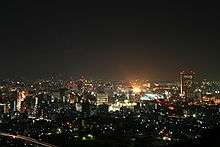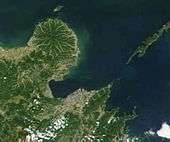Futoshi Matsunaga
| Futoshi Matsunaga | |
|---|---|
| Born |
Futoshi Matsunaga April 28, 1961 Kitakyushu, Fukuoka, Japan |
| Killings | |
| Victims | 7–9 |
Span of killings | 1996–1998 |
| Country | Japan |
| State(s) | Kitakyushu, Fukuoka |
Date apprehended | 2002 |
Futoshi Matsunaga (松永 太 Matsunaga Futoshi, born April 28, 1961) is a Japanese serial killer who both defrauded and tortured his victims in what is publicly known as the Kitakyūshū Serial Murder Incident (北九州連続殺人事件). He was convicted of six counts of murder and one count of manslaughter between 1996 and 1998 and sentenced to die by hanging. He murdered his victims with an accomplice, Junko Ogata, who received a life sentence.
His crimes were so atrocious that most mass media were not willing to report the details.[1][2] The Japan Times reported that prosecutors said "[the case] is without comparison in the criminal history of our country".[3] Several writers, including Ryūzō Saki, published the details of the crimes.
Early life

Matsunaga was born in Kokurakita Ward of the city of Kitakyūshū in Fukuoka Prefecture, and grew up in Yanagawa. He received good grades in school and had a charming personality, but tended to exhibit disciplinary problems. He was transferred to another high school after engaging in a relationship with a junior high school girl. He married at 19 and had a son.
Despite being married, Matsunaga was involved with at least ten mistresses. In October 1982, during his marriage, he became involved with Junko Ogata, one of his former schoolmates from Yanagawa. In 1984, Matsunaga promised to marry Junko, but her mother, Shizumi Ogata, did not approve of the relationship because of Matsunaga's abuse of her daughter. Matsunaga raped Shizumi as a result. In 1985, Matsunaga convinced Junko that her family hated her because of a suicide attempt and persuaded her to move in with him.[4]
That same year, Matsunaga also purchased a building in which he could operate a futon business. Afterwards, he began to electrically shock employees on the third floor.[5] He would sometimes suddenly shout towards other men, saying things like, "There is a spirit behind you! It is sucking away your fortune!" He also made references to religious terms like saṃsāra and kami.[6] By 1992, Matsunaga had stolen 180 million yen (about US$2.2 million) through fraud or blackmail.[6] He and Junko evaded police capture and were put on Japan's most wanted list.
Murders
Matsunaga lived in a condominium in Kokurakita-ku. His first victim was a married woman with three children. In April 1993, he convinced her to leave her husband and run away with him, telling the woman that Junko was his sister. One of her children died under mysterious circumstances in September 1993. Her two other children went to live with their father and grandfather the following month. During their relationship, Matsunaga defrauded the woman for 11.8 million yen (about US$145,510). She died mysteriously in March 1994, and the police were unable to prove that Matsunaga had killed the woman or her child.[7]
Later that year, Matsunaga began victimizing Kumio Toraya and his daughter. Kumio had previously confided to Matsunaga about his previous criminal history; Matsunaga used this information to blackmail Kumio. Kumio and his daughter were held captive in Matsunaga's room inside the condominium. Matsunaga tortured Kumio with electric shocks, forced him to eat his own feces, and forced his daughter to bite her father.[7] Kumio died as a result of this abuse on February 26, 1996. Matsunaga convinced Kumio's daughter that she had murdered her father.[7] He told Junko and the girl to dispose of the remains, which were thrown into the sea near the Kunisaki Peninsula after being pulverized.

Soon after, Matsunaga found another target in a female acquaintance of Kumio. He convinced the woman that he was a graduate of Kyoto University and promised to marry her. Instead, he defrauded her of 5.6 million yen (about US$69,066). As before, the woman and her daughter were confined to Matsunaga's room. The woman escaped by jumping from the second floor to the ground in March 1997. She was put into the care of a mental hospital and her daughter was released.
The following month, Ogata left for work and did not return. Matsunaga contacted her family, threatening them and blackmailing Shizumi over the 1985 rape. Matsunaga then faked his own suicide, prompting Ogata to return and be subjected to continued abuse. He also raped Ogata's married sister, Rieko. Ogata's family gave 63 million yen (about US$777,116) to Matsunaga, after which he held them captive and psychologically controlled them in ways similar to the methods of cult-leader Shoko Asahara.[8]
On December 21, 1997, Matsunaga coerced Junko to shock her 61-year-old father, Takashige, to the point of death. When Shizumi's mental state began to deteriorate, Matsunaga commanded Rieko and her husband Kazuya to strangle her on January 20, 1998. Several weeks later, he commanded Kazuya to strangle Rieko, while their 10-year-old daughter Aya held her down. Matsunaga and Ogata then confined Kazuya to a bathroom, where he starved to death on April 13, 1998. Matsunaga then forced Junko, Aya, and Kumio's daughter to kill Rieko's 5-year-old son, Yuki.
During the trial, Kumio's daughter testified that Matsunaga and Ogata had tortured Aya with electricity. Ogata denied this testimony, saying the girl's recollections might have been inaccurate because of guilty feelings about committing her first murder. Kumio's daughter strangled Aya on June 7, 1998.
Matsunaga and Ogata dismembered and boiled their victims' remains in pots. The other residents of the condominium heard strange noises and smelled the stench. The victims' remains were finally disposed of in washrooms or put out to sea. The condominium was renovated after the murders. Matsunaga blamed the murders on Ogata, who, with their two children, were the only survivors in her family.
In July 2000, Matsunaga convinced another woman to go away with him, lured by the prospect of marriage. In August 2001, she gave her twin children to him and Ogata. Matsunaga and Ogata then convinced the woman to give them 20 million yen (about US$246,580), telling her that they would need the money to bring up her children.
Arrest and trial
Kumio's daughter, who was being held captive, escaped from Matsunaga on January 30, 2002, but Matsunaga found the girl on February 15, 2002, and took her back into captivity. He then tortured the girl with electric shocks.[3]
On March 6, 2002, the girl escaped from Matsunaga again, and reported the crimes to the police. She was 17 years old. The police arrested Matsunaga and Ogata the next day when they tried to retrieve the girl. The twins and the couple's two children were taken into police protection.
The media initially reported only that Matsunaga and Ogata had held their victims captive, similar to the case of Fusako Sano, but eventually the media revealed the details of the murders Matsunaga and Ogata had committed.
The pair were charged with Aya's murder on September 18, 2002; Takashige's murder on October 12, 2002; Shizumi's murder on December 6, 2002; Yuki's murder on January 11, 2003; Kumio's murder on February 3, 2003; Rieko's murder on February 25, 2003; and Kazuya's murder on May 30, 2003.
No murder charges were brought against Kumio's daughter. Ogata calmly confessed to her part in the murders, but Matsunaga professed his own innocence. He insisted that the women had fabricated their stories about him. The Japanese police never recovered any human remains and found no physical evidence, so they relied primarily upon the testimonies of Kumio's and Ogata's daughters during the police investigation.
On September 28, 2005, a district court in Fukuoka sentenced Matsunaga and Ogata to die by hanging.[4] The court tried six cases, but considered that Matsunaga and Ogata had not killed Takashige directly, but had only injured him by electric shocks which later resulted in his death.
The pair appealed the verdict. On September 26, 2007, a high court upheld Matsunaga's original sentence, but Ogata's sentence was changed from death by hanging to life imprisonment because Matsunaga had exerted control over Ogata to force her to kill the victims.[9]
Victims
- Kumio Toraya (虎谷 久美雄 Toraya Kumio) – The girl's father[10]
- Takashige Ogata (緒方 誉 Ogata Takashige) – Junko's father
- Shizumi Ogata (緒方 静美 Ogata Shizumi) – Junko's mother
- Rieko Ogata (緒方 理恵子 Ogata Rieko) – Junko's sister
- Kazuya Ogata (緒方 主也 Ogata Kazuya) – Rieko's husband
- Yūki Ogata (緒方 優貴 Ogata Yūki) – Junko's nephew
- Aya Ogata (緒方 彩 Ogata Aya) – Junko's niece
See also
- Milgram experiment — experiment using electric shocks
- Concrete-encased high school girl murder — another high-profile torture murder in Japan
- Capital punishment in Japan
Further reading
- Ryūzō Saki (2005) なぜ家族は殺し合ったのか (Naze kazoku wa koroshiatta noka, translation; Why did the family kill each other?) ISBN 4-413-04120-8
- Masayoshi Toyoda (2005) 消された一家 北九州・連続監禁殺人事件 (Kesareta ikka: kitakyūshū renzoku kankin satsujin jiken, translation; The Extinguished Family—Serial Captivity-Murders Case in Kitakyushu) ISBN 4-10-300511-4
References
- ↑ 夏樹静子が見た北九州監禁殺人裁判 (in Japanese). RKB Mainichi Broadcasting. 2005-06-13. Retrieved 2008-06-26.
- ↑ 中国媒体未能报道的日本杀人案背后 (in Chinese). JNOC NEWS. 2005. Retrieved 2008-02-12.
- 1 2 "Pair accused of slaying 7 face gallows". The Japan Times WEEKLY. 2005-03-12. Retrieved 2008-02-10.
- 1 2 "Pair to hang for seven murders". The Japan Times. 2005-08-29. Retrieved 2008-02-10.
- ↑ 脅しの“原点”電気責め、松永被告20代から (in Japanese). Yomiuri Shimbun. 2002-09-19. Archived from the original on 2008-02-01. Retrieved 2008-03-17.
- 1 2 松永被告「奇妙な顔」、宗教的言動で支配 (in Japanese). Yomiuri Shimbun. 2002-09-25. Archived from the original on September 24, 2009. Retrieved 2008-03-17.
- 1 2 3 一家惨殺 (in Japanese). MONSTER. Retrieved 2007-11-29.
- ↑ なぜ家族は殺し合ったのか (in Japanese). Mitsuharu Matsumoto Laboratory. 2008-03-08.
- ↑ "Man's death sentence upheld, woman's reduced to life in murders". BREITBART COM. 2007-09-26. Retrieved 2008-02-10.
- ↑ 逼骨肉相残 行大逆不道 / 北九州连续杀人犯全盘供述 (in Chinese). Chubun Doho. April 2004. Retrieved 2010-09-03.
External links
- Futoshi Matsunaga from "serial killer true crime library"
- Captive boys rescued from condo The Japan Times, March 11, 2002
- Girl's confiners reveal names The Japan Times, March 14, 2002
- Pair accused of slaying seven face gallows The Japan Times, March 3, 2005
- Pair accused of slaying 7 face gallows The Japan Times, March 12, 2005
- Pair to hang for seven murders The Japan Times September 29, 2005
- Death sentence reduced for one of murderous pair The Japan Times, September 27, 2007
- (Chinese) The serial murders case The Sun, October 30, 2005
- (Chinese) The serial murders case by JNOC NEWS
- (Japanese) Kitakyushu Serial Murders 北九州連続殺人事件
- (Japanese) Family Murders 一家惨殺 – from MONSTERS
- (Japanese) Japanese Wikipedia entry on the murders